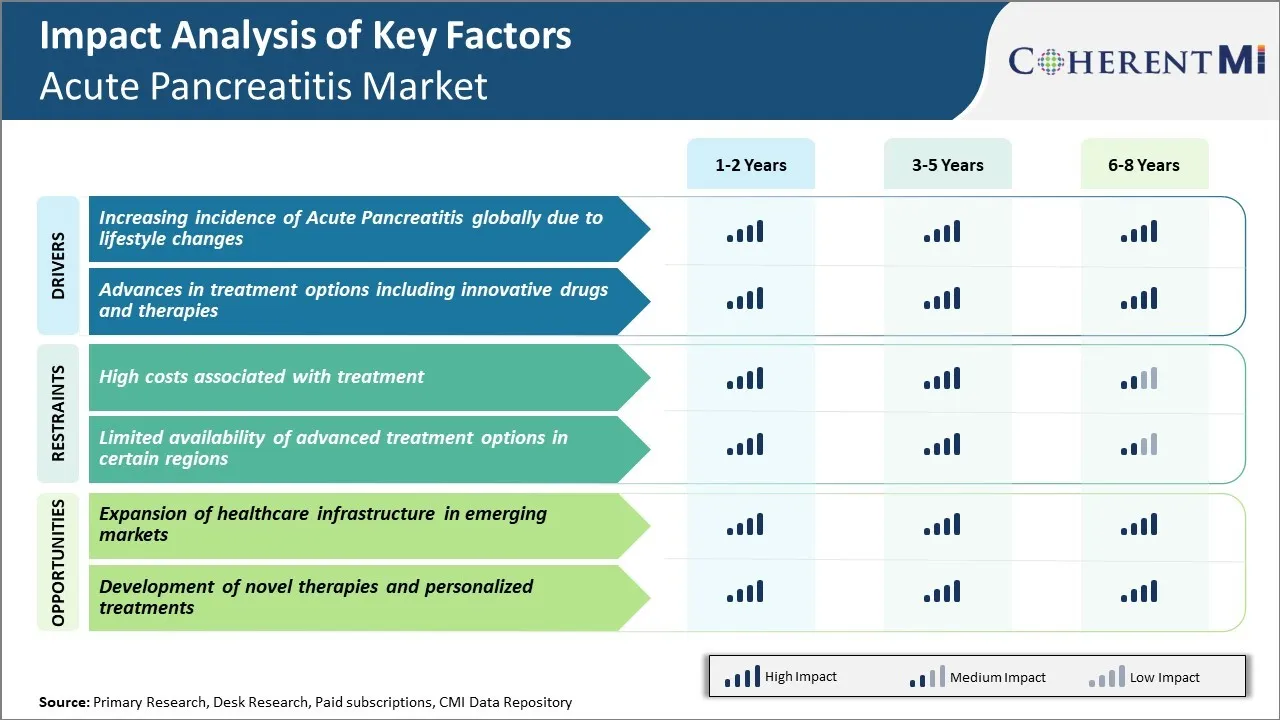急性胰腺炎 市场 规模与份额分析 - 成长趋势与预测 (2024 - 2031)
急性胰腺炎 市场按治疗(药物治疗、辅助护理、外科手术)、最终用户(医院、诊所、门诊外科中心)、原因(石块、慢性酒精使用、其他)、分销渠道(医院药房、零售药房)、地理(北美、拉丁美洲、亚太、欧洲、中东和非洲)划分。 本报告提供了上述价值(百万美元)。....
急性胰腺炎 市场 规模
市场规模(美元) Mn
复合年增长率4.5%
| 研究期 | 2024 - 2031 |
| 估计基准年 | 2023 |
| 复合年增长率 | 4.5% |
| 市场集中度 | Medium |
| 主要参与者 | 武田制药公司, 诺华集团, 辉瑞股份有限公司., 葛兰素史密斯Kline, 阿比维公司. 以及其他 |
请告诉我们!
急性胰腺炎 市场 分析
急性胰腺炎市场估计值为: 2024年522.5百万美元 预计将达到 至2031年7108万美元以复合年增长率增长 2024年至2031年,占4.5%。 。 。 胆石疾病和酒精消费的发病率上升是导致急性胰腺炎病例增加的主要因素。 急性胰腺炎给全世界带来沉重的疾病负担,住院率和死亡率都很高。
急性胰腺炎 市场 趋势
市场驱动器 -- -- 生活方式的改变助长急性胰腺炎的上升 案例
过去几十年,全球急性胰腺炎发病率稳步上升。 这一增长的一个关键因素是越来越多的人普遍改变生活方式。 健康不良的饮食习惯、身体不活动、过度饮酒和吸烟是生活方式的一些主要方面,被认为是发展急性胰腺炎的重要风险因素。
同样,酒精摄入量过大也非常普遍,特别是在较年轻的人口群体中。 许多人几乎认为饮酒是随意社交。 但医学研究已明确显示,大量零星或定期饮酒容易引发急性胰腺炎袭击. 同样,尽管开展了反烟草运动,全世界吸烟者的人数仍然高得惊人。 吸烟是一个公认的风险因素,在许多急性胰腺炎病例中都涉及到这一因素。
上述所有促进增重,代谢失调,给消化器官增加压力的生活方式,都导致急性胰腺炎的出现激增. 除非作出协调一致的努力,促进大规模地改变更健康的生活方式,否则,未来几年内,由不适当的现代生活方式引起的急性胰腺炎病例将继续增加。
市场驱动力----急性胰腺炎治疗方案的进展
取得实质性进展的关键领域之一是药物开发,用于治疗根本原因和调节疾病过程。 在过去十年中,一些临床试验评估了不同的药物,这些药物有助于减少胰腺炎并加速恢复。 正在调查的几类有前途的药物包括酶抑制剂,抗氧化剂,抗炎剂和某些免疫剂. 如果证明安全有效,这些较新的药物制剂将加强临床医生的军备库,以处理急性胰腺炎病例。
同时,最小程度的入侵性外科手术技术和干预性内视选择也正在逐渐流行。 诸如内分泌的复古胆囊造影法(ERCP)等程序,能够诊断和处理经常引起胰腺炎攻击的胆结石等情况。 同样,将排水槽置于有问题的胰腺管道的程序正在推动对并发症的管理。 先进成像法和图像制导精度的结合进一步加强了这种干预方法。
总体而言,在一系列创新药物和技术的支持下,不断改进治疗模式,这预示着改善急性胰炎患者的结果和生活质量。 预计这一进展将加强这一行业的商业前景,因为这一行业对更先进、更有效的治疗方法的需求将高于传统的护理标准。

市场挑战 -- -- 与治疗有关的高成本
急性胰腺炎市场面临的主要挑战之一是与治疗有关的高昂费用。 急性胰腺炎需要住院治疗和强化医疗。 治疗包括广泛监测静脉注射液和止痛药。 在严重的情况下,可能需要外科手术,这进一步增加了总费用。
由于疾病的复杂性,每个病人的治疗费用相当高。 根据估计,美国每名病人的平均总费用在15 000至30 000美元之间,视严重程度而定。 这给病人及其家庭带来了巨大的经济负担. 此外,住院医院与急性胰腺炎有关的住院时间很长,给各区域已经负担过重的保健系统带来了额外的费用压力。
随着急性胰腺炎发病率的上升,治疗方面的开支预计将大幅增加。 然而,保健预算的局限性和报销方面的挑战对解决日益加重的疾病负担构成了制约。 这是一项重大的市场挑战,需要加以解决,以确保获得负担得起的护理。
市场机会——扩大新兴市场的保健基础设施
急性胰腺炎市场的主要机会之一是扩大新兴市场的保健基础设施。 在发展中国家,越来越多的投资用于建设保健设施和改善获得先进治疗的机会。
这包括建立新的医院,扩大农村地区的医疗基础设施,以及各国政府增加人均保健开支。 由于这些事态发展,现在有更多的病人能够及时治疗急性胰腺炎,即使在偏远地区也是如此。
此外,提高诊断能力有助于及早发现和管理该疾病。 这一因素正在对新兴国家的市场增长产生积极影响。 由于计划进一步投资于加强保健系统,预计新兴市场将在今后几年为急性胰腺炎市场的参与者提供显著的扩展前景。 公司可以通过注重这些高潜力地区和满足不断增长的医疗需求而获得竞争优势。
处方者偏好 急性胰腺炎 市场
急性胰腺炎有三个确定的阶段:轻度、中度和重度。 对轻度病例的初步治疗主要是使用静脉注射阿片剂等止痛药进行疼痛管理。 口服摄入量受到限制,IV水合开始. 随着病情的缓解,患者逐渐进入口服液和饮食摄入阶段.
中度病例为预防感染而增加了抗微生物. 常见的处方是阿米诺格利科斯(Aminoglycoside),如阿米卡辛(amikacin)和第三代乙二醇(caftriaxone). 同时还开始提供营养支持,提供IV喂养。
严重病例涉及对并发症的管理,这决定了治疗。 对于受感染的坏死,更喜欢广谱抗生素,覆盖中子素和中子素等肠道植物. 恐怖的坏死可能需要像下水道那样的干预。 呼吸衰竭需要呼吸器支持。 血动力不稳定导致输血素的使用,例如诺雷松素和多巴胺.
处方在选择治疗方法时,会考虑疾病的严重程度、个别风险因素、并发症、当地抗微生物抗药性模式和医院规程。 成本是另一个因素,特别是对于昂贵的生物学而言。 假标签使用药物,如becaplermin和nesiritide,显示出希望,但在广泛采用之前需要更多的证据。 胃肠科医生、外科医生和强化医师的多学科投入进一步帮助指导最佳管理。
治疗方案分析 急性胰腺炎 市场
急性胰腺炎有三个主要阶段:轻度、中度和重度。 轻微的发炎病例可用小肠休息、IV液和止痛药进行辅助治疗。 目标是纠正脱水和电解质不平衡.
对于炎症或器官机能失调程度较高的中度病例,可能需要额外的治疗步骤. 抗生素有时被预防性使用,因为胰腺坏死会增加感染风险. 最常用的抗生素是甲状腺素(mersolyl)或伊米苯(imipenem/cilastatin),它们广泛覆盖肠道和胰腺细菌。
在严重的急性胰腺炎中,需要进行积极的治疗,以防止可能危及生命的多器官衰竭。 除IV液,止痛药,以及可能还有抗生素外,其他干预措施可能包括异狄氏霉素假药,以减少胰腺炎或Somatostatin/octreotide IV,以减少外分泌. 对于坏死性胰腺炎来说,由于风险较低,在可能情况下比外科手术更为可取,如对受感染的液体收集进行近皮排水或内皮排水。
在中度和重度病例中,通过用半元素配方喂食的Nasojejunal管提供营养支持特别重要,可防止营养不良,促进治疗,减少长期住院的费用。 总体治疗包括采用多学科方法,根据每个个案的严重程度和并发症提供连续护理。
关键参与者采用的关键制胜策略 急性胰腺炎 市场
注重开发新型药物制剂:开发新药配方治疗急性胰腺炎是玩家采取的关键策略. 2018年,Twist Bioscience与AbbVie合作开发了治疗急性胰腺炎的新型单克隆抗体. 第一阶段临床试验显示有希望的结果,没有不利影响。 这种新颖的提法改善了结果,减少了病人的住院治疗。
扩大管道的购置和伙伴关系:公司已经收购或与其他角色合作,以扩大其产品管道. 2020年,Nestle Health Science收购了一家专注于开发包括急性胰腺炎在内的胰腺障碍AI解决方案的生物技术公司Anumana. 这使得内斯特尔获得了阿努马纳的输油管药物和AI技术来预测耀斑,这是一个大赢家.
地理扩张数字 : 玩家注重向亚太和拉丁美洲等有利可图的新兴市场扩展,预计这些地区将成为急性胰腺炎治疗的高增长区域。 2019年,AbbVie通过推出用于治疗胰腺炎的胰腺酶替代药物Creon而扩张到中国. 在一年内,它占中国市场的15%以上,显示了潜力。
区别对待的供货:提供不同待遇选择的公司,如最低程度侵入性程序,出现了强劲增长。 2017年,波士顿科学公司推出了SpyGlass直接视觉系统,允许通过口腔检查胰腺管,减少患者的疼痛和康复时间. 它捕获了60%新兴的胰腺自清洁器械市场.
分段分析 急性胰腺炎 市场
透视,通过治疗:侵略性药物开发驱动药物 治疗部分的增长
在治疗方面,药物疗法对各大制药公司积极研发新药的市场贡献最大。 药物治疗仍然是急性胰腺炎的主要治疗方法,以控制疼痛和炎症。 蛋白质抑制剂,反秘密剂,胰腺酶替代等现有药物类已经表现出一定的疗效,但伴随着副作用和其他挑战. 这促使制药公司大力投资发展新的药物实体。
许多候选药物目前正在临床试验中,有几种在晚期测试. 正在调查的一些最有前途的药物类别包括特普辛抑制剂,抗氧化剂,抗炎剂,以及基因治疗应用. Trypsin抑制剂通过阻断激活诸如trypsinogen等在胰腺炎攻击中引起胰腺自消化的酶而起作用.
在基因疗法方面,研究人员正在探索利用经过修改的病毒将基因材料送入胰细胞,以阻断特定的炎症途径,减少锥虫活性. 如果证明是安全有效的,基因疗法有可能使胰腺炎治疗发生革命性变化。 总体而言,这些新颖的药物候选人的巨大发展管道和成功潜力是将药物治疗部分保持在急性胰腺炎现有治疗选择的最前沿的主要驱动力。

透视, by end User: 医疗保健基础设施驱动器 医院部分共享
就最终用户而言,医院占市场的份额最高,因为大多数国家都建立了良好的保健基础设施。 急性胰腺炎往往需要住院治疗、强化监测和提供专家。 它可能造成影响可能需要多学科管理的其他器官系统的并发症。 如果需要手术,医院最适合提供这种复杂的护理和进行侵入性手术。 大多数国家都制定了政策和保险模式,鼓励在医院治疗急症,而不是其他环境。
发达国家尤其拥有综合医院网络,拥有先进的设施、设备和人员配备,可以处理甚至严重的胰腺炎病例。 主要医院有专门的胰腺科、重症监护单位和高端诊断技术,可吸引严重的胰炎病例。 医院的护理和辅助医务人员也接受专门培训,以密切监测病人并识别病情恶化。 住院住院可以进行适当的液体/电解液管理,必要时通过静脉注射途径提供药物,并在紧急情况下立即进行干预或手术。 保健资源集中在医院,使得它们成为急性胰腺炎护理的优先选择,维持了它们在这部分的市场份额。
透视,根据原因:高疾病负担驱动Gallstone引起的胰腺炎
就原因而言,胆结石占最高份额,因为胆结石是急性胰腺炎袭击最常见的导火索。 胆囊中所含的胆囊结晶成坚硬的卵石状矿床时,盖尔石形成. 在攻击中,这种胆囊石可能会意外地阻断常见的胆囊管,引起酶的备份进入胰腺. 这种自动消化引发破坏性的炎症反应,导致急性胰腺炎.
由于生活方式和饮食因素,导致胆固醇结晶如肥胖,高卡路里饮食,以及身体不活动,盖尔石岩主要发育. 不幸的是,这些风险因素在世界范围内急剧上升。 肥胖症、代谢综合症和糖尿病在全球日益流行,在过去几十年里,许多国家的胆囊病发病率激增。
正在经历营养过渡的国家的胆石形成量急剧增加。 随着胆石疾病负担的增加,通过阻塞胆石引起的胰腺炎攻击次数也随之增加. 除非生活方式发生急剧变化,否则胆固醇在可预见的未来很长一段时间内很可能保持其作为急性胰腺炎主要病因的地位。 胆囊肿胀的病人群确保了对这一部分的持续需求.
附加见解 急性胰腺炎 市场
- 对药物试验和主要公司之间的伙伴关系进行全面审查,以解决急性胰炎市场的未满足需求,正在形成市场动态。 这些伙伴关系旨在缩短住院时间和改善治疗结果。
- 急性胰腺炎市场的增长也由于医疗基础设施改善导致诊断率上升,在发展中国家尤其如此。 亚太的诊断率在过去五年中增加了15%,成为市场增长最快的地区之一。
竞争概览 急性胰腺炎 市场
在急性胰腺炎市场运营的主要角色包括武田制药,诺华AG,辉瑞股份有限公司,葛兰素史密斯Kline,以及AbbVie股份有限公司.
急性胰腺炎 市场 领导者
- 武田制药公司
- 诺华集团
- 辉瑞股份有限公司.
- 葛兰素史密斯Kline
- 阿比维公司.
急性胰腺炎 市场 - 竞争对手

急性胰腺炎 市场
(主要参与者主导)
(竞争激烈,参与者众多。)
最新发展 急性胰腺炎 市场
- 2023年7月,武田制药公司宣布其急性胰腺炎药物管道有重大发展,有可能将恢复时间缩短20%. 预计这一进步将增加他们的市场份额,并为患者提供更快的康复解决方案。
- 2024年3月,辉瑞公司与欧洲医学院发起一个合作项目,以加强急性胰腺炎的早期诊断方法,这可以大大改善患者的结果和市场竞争力。 辉瑞公司一直积极参与各种保健举措,包括诊断和治疗领域的伙伴关系和创新。
急性胰腺炎 市场 细分
- 治疗
- 药物治疗
- 辅助护理
- 外科手术
- 按终端用户
- 医院
- 诊所
- 门诊中心
- 根据原因
- 盖尔石
- 慢性酒精 使用
- 其他人员
- 按分发频道
- 医院药房
- 零售药店

您想要了解购买选项吗?本报告的各个部分?
常见问题 :
急性胰腺炎市场有多大?.
急性胰腺炎市场估计在2024年价值522.5万美元,预计到2031年将达到7108万美元。
阻碍急性胰腺炎市场增长的关键因素是什么?
某些区域与治疗有关的高成本和有限的先进治疗选择是阻碍急性胰腺炎市场增长的主要因素。
促使急性胰腺炎市场增长的主要因素是什么?
由于生活方式的改变以及包括创新药物和治疗方法在内的治疗方法的进步,全球急性胰腺炎的发病率不断上升,是导致急性胰腺炎市场的主要因素。
哪些是急性胰腺炎市场的主要治疗方法?
主要的治疗部分是药物治疗。
谁是在急性胰腺炎市场经营的主要角色?
武田制药,诺华AG,辉瑞股份有限公司,葛兰素史密斯Kline,AbbVie股份有限公司是主要球员.
急性胰腺炎市场的CAGR是什么?
急性胰腺炎市场的CAGR预计将在2024-2031年达到4.5%.